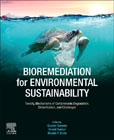
Bioremediation for Environmental Sustainability: Toxicity, Mechanisms of Contaminants Degradation, Detoxification and Challenges
Saxena, Gaurav
Kumar, Vineet
Shah, Maulin P.
Environmental safety and sustainability with rapid industrialization is one of the major challenges worldwide. Industries are the key drivers in the world economy, but these are also the major polluters due to discharge of potentially toxic and hazardous wastes containing various organic and inorganic pollutants, which cause environmental pollution and severe toxic effects in living beings. Bioremediation for Environmental Sustainability: Toxicity, Mechanisms of Contaminants Degradation, Detoxification and Challenges introduces pollution and toxicity profile of various organic and inorganic contaminants, mechanism of toxicity and degradation and detoxification by microbes and plants and their bioremediation approaches for environmental sustainability. It also covers many advanced technologies in the field of bioremediation and phytoremediation, including electro-bioremediation, microbial fuel cells, nano-bioremediation, constructed wetlands, phytotechnologies and many more, which are lacking in other competitive titles existing in the market. Further, it includes updated information as well as future direction for research in the field of bioremediation of industrial wastes. This book is a reference to students, researchers, scientists and professionals in field of microbiology, biotechnology, environmental sciences, eco-toxicology, environmental remediation and waste management, who aspire to work on the biodegradation and bioremediation of industrial wastes/environmental pollutants for environmental sustainability. Introduces pollution and toxicity profile of environmental contaminants and industrial wastes, including oil refinery wastewater, distillery wastewater, tannery wastewater, textile wastewater, mine tailing wastes, plastic wastes, and moreDescribes underlying mechanisms of degradation and detoxification of emerging organic and inorganic contaminants with enzymatic rolesFocuses on recent advances and challenges in bioremediation and phytoremediation, including microbial enzymes, biosurfactants, microalgae, biofilm, archaea, genetically engineered organisms and more INDICE: Section I. Introduction to Bioremediation 1. Bioremediation: Principles and Applications in Environmental Management 2. Phytoremediation of Heavy Metals-Contaminated Soils: Recent Advances and Challenges Section II. Bioremediation of Inorganic Contaminants 3. Hexavalent Chromium: Toxicological Profile and Biodetoxification Mechanisms for Bioremediation 4. Arsenic Contamination in Environment: Environmental and Health Hazards and Bioremediation Approaches for Detoxification 5.Cadmium Contamination in Environment: Environmental and Health Hazards and Bioremediation Strategies 6. Phytoremediation of Selenium: Challenges and Future Prospects 7. Role of Endophytes in Bioremediation of Heavy Metals: Challenges and Prospects 8. Role of Aquatic Macrophytes in Heavy Metals Removal from Industrial Wastewaters Section III. Bioremediation of Organic Contaminants 9. Ecotoxicological and Health Effects of Persistent Organic Pollutants (POPs) and Their Biodegradation and Bioremediation 10. Toxicity Profile and Bioremediation Approaches for Polyaromatic Hydrocarbons (PAHs) 11. Toxicity Profile and Bioremediation Strategies for Organophosphate Pesticides 12. Toxicity Profile and Phytoremediation Approaches for Organic Pollutants: A Review 13. Toxicity Profile of Pentacholorophenol and Bioremediation Strategies 14. Toxicity Profile of Polychlorinated Biphenyls and Bioremediation Approaches 15. Role of Endophytes in Bioremediation of Organic Contaminants: Challenges and Prospects 16. Toxicity Profile and Biodegradation of Chlorinated Compounds 17. Toxicity Profile and Biodegradation of Nitro-Aromatic Compounds 18. Environmental Hazards of Lignocellulosic Waste and Its Biodegradation 19. Toxicity Profile and Biodegradation of Hexachlorocyclohexane (HCH) 20. Environmental Hazards, Toxicity Profile and Bioremediation Approaches for Azodyes Section IV. Bioremediation of Industrial Wastes 21. Bioremediation Approaches for Industrial Acid Mine Tailing Wastes: Potential Issues and Prospects 22. Environmental Contamination, Toxicity Profile and Bioremediation Approaches for Distillery Effluent 23. Environmental Hazards and Biodegradation of Plastic Waste: Challenges and Future Prospects 24. Environmental Contamination, Toxicity Profile and Bioremediation Approaches for Textile Effluent 25. Environmental Contamination, Toxicity Profile and Bioremediation Approaches for Pulp Paper Industry Effluent 26. Toxicity Profile and Bioremediation Approaches for Tannery Wastewater 27. Microalgae as Agents for Industrial Effluent Treatment: Opportunities and Challenges 28. Applications of Cyanobacteria in Industrial Effluent Treatment: Opportunities and Challenges Section V. Recent Advances and Challenges in Bioremediation 29. Genetically Engineered Microbes in Biodegradation and Bioremediation of Environmental Pollutants: Challenges and Prospects 30. Applications of Biosurfactants in Environmental Management: Challenges and Prospects 31. Diversity and Applications of Archaea in Bioremediation of Environmental Contaminants 32. Microbial Enzymes and Role in Bioremediation of Environmental Pollutants: Prospects and Challenges 33. Engineering Aspects and Roles of Biofilm in Bioremediation of Environmental Contaminants
- ISBN: 978-0-12-820524-2
- Editorial: Elsevier
- Encuadernacion: Rústica
- Páginas: 512
- Fecha Publicación: 01/10/2020
- Nº Volúmenes: 1
- Idioma: Inglés
